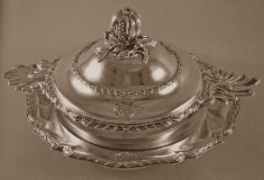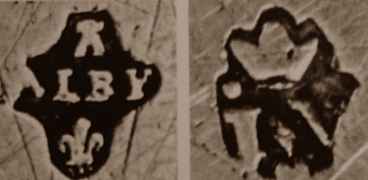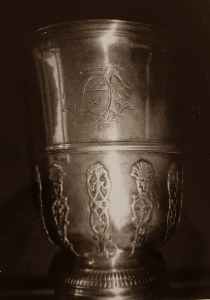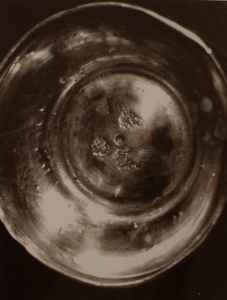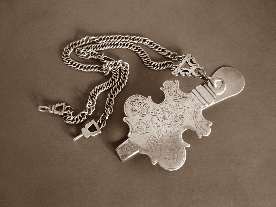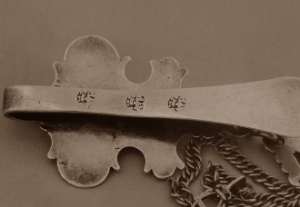by Lise
Moor
(click on photos to enlarge image)
THE TRIPLE MASTER SILVERSMITH MARK ON FRENCH SILVER
ARTIFACTS FROM 1672 TO 1798
(PART 1) THE MARKING OF SUBSCRIBER-MASTERS UNDER THE "ANCIEN
REGIME"
It is not rare for collectors and dealers to find French
silver artifacts of the 18th century bearing the master
silversmith mark repeated three times. When an object bears only
the master's mark repeated three times (of the whole series of
marks), usually the piece is attributed to a subscriber-master
("Maître-Abonné").
Key holder (clavandier), by master
silversmith Antoine II Parrel,
Le Puy en Velay, 18th century
|
The silversmith's mark is repeated
three times
(Private Collection)
|
After a brief review of existing legislation, I will try to
demonstrate if this attribution correct, to specify the criteria
followed by subscriber-masters in the marking of their works and
the meaning of the triple punch of master's mark.
HISTORICAL BACKGROUND OF THE LAW
The "Droit de Marque" (tax on works of gold and silver
produced in France) was established by the Declaration of Louis
XIV of March 31, 1672 [1a] and the Charge and Décharge system
was approved on August 5, 1677 [1b].
The Regulation of 30 December 1679 established that "the
goldsmiths will be required to mark the articles made of gold
and silver and to countermark them on a visible place" [2a]. The
countermark, called "poinçon de jurande" testifies the
silver fineness of the object.
The control rights were conferred to a "Ferme Générale"
and from 1 October 1774 to a "Régie"). The Ordinance of
July 22, 1681 obliged the silversmith, after the apposition of
the "poinçon de jurande", to present the object (till in
raw state) to the "Ferme Générale" to obtain the "poinçon
de charge". This proceeding obliged the silversmith to represent
to the "Ferme Générale" the finished object to obtain the
"poinçon de décharge" after the payment of the fees [2b].
In the towns where the "jurande" was not present, the
silversmiths were required to apply this duty to the offices of
nearby towns [2c].
Silver pieces manufactured in the French Kingdom between 1677
and 1791 requested the presence of four different marks, while
in the provinces only three marks were present ("communauté", "reconnaissance"
and master). Notwithstanding these provisions have never been
expressly revoked, we find pieces (approximately dated to the
period of activity of the silversmith) bearing the maker's mark
repeated three times. These items are usually attributed to "Subscribers
Masters".
These were silversmiths residing in towns where the "jurande" or
the "Bureau de la Marque" were not present, imposing costly and
dangerous journeys for the "Charge" and "Décharge" of their
artifacts. In these cases they could contract with the "Ferme
Générale" an annual subscription fee based on their
estimated production.
There were no "Subscribers Masters" residing in Paris, nor in
the recently annexed provinces, as they were not subject to the
payment of the fee.
I will try to clarify the situation of these "Subscribers
Masters" in the light of some ancient documents.
In some cases the subscription agreement specified that the
pieces were subject to marking in accordance with the
regulations of "charge" and "décharge".
- from 1/10/1684 to 30/9/1689, Sulpice Symon entered in the "sous-ferme"
of Avallon, making a subscription agreement with the
silversmiths for the payment of the fee and instructing his
clerk for the marking of silver pieces. [3a].
- from 1698 to 1703, in Macon and Bourg-en-Bresse, from 1744 to
1780 in Dijon where there was a "jurande", the "Subscriber
Masters" were obliged to mark their works with "charge" and "décharge"
marks. [4a].
- on July 1, 1739, the "sous-fermier" of the town of Laon
adopted two different marks, depending on whether or not the
silversmiths were "Subscribers" [15a].
|
Régie
|
Subscriber
|
large works
|
hand
|
Fleur de lys crowned
|
old works
|
Greyhound
|
heart surrounded by three fleurs de lys
|
small works
|
rose
|
tower
|
for items that can not bear the mark
|
royal sceptre with fleur de lys
|
lys
|
- there were towns where to entire "Communauté" had a
subscription agreement. In such cases the "Communauté" often
used a special mark replacing those of the "Fermier".
- one of the oldest subscription agreement (signed in Bourges,
July 19, 1673) stated that the punch (representing a sheep) was
given to Charles Bérault for delivering to the silversmiths for
the marking of their works [14b].
- at the end of the subscription period running from 1674 to
1676, the silversmiths applied for the "décharge" of their works
marked with the "charge" mark "Y over a fleur de lys" [14c].
- from 1 October 1680 Troyes' silversmiths stipulated a six
years subscription agreement. To mark their works they used a "fleur
de lys with S" mark [16a] (in 1679 Troyes' mint was
transferred to Reims).
- with the subscription agreement signed on
December 21, 1694 the silversmiths were exempted
from verification of their work. They were requested
to use a mark with "D surmounted by two fleur de lys,
a point and a crown" [16b]. The silversmiths were
requested to return the punch at the termination of
the agreement.
|

|
| . |
Mark attributed to "Subscriber Masters" from
January 1, 1695 to September 1697 (mark described by
S. Brault-Lerch)
|
On April 6, 1724, during a trial, the silversmith Claude
Testelette says that he is exempted to keep records of his
activity as he is a "Subscriber Master" [14d] - The April 18,
1777 sentence of the Cour des Aides cerifies that Chaumont "Subscriber
Master" Julien Alaterre marked his works with a special punch
which replaced the Fermier "décharge" mark [2h] (mark is not
described).
- In October 1750, the "Fermier Général" Julian Bertha
registered the firs mark for "Subscribers Masters", "tourteau en
abîme, a star below" [1c]. This mark has been impressed in 1772
by Jean-Jacques Prevost on the copper table of the "Cour des
Monnaies" by Jean-Jacques Prevost in 1772, then by Alaterre in
1768 and disappeared (not replaced) with the Régie of Fouache (I
never saw an object with this mark).
Today, we are accustomed to attribute to "Subscriber Masters"
the works bearing a triple maker's mark. Is this practice
justified?
The examination of some contract of subscription provides some
answers.
- Following a trial about some pieces received back, Henry Briet,
silversmith in Carcassonne, on June 21, 1681 benefits of this
measure: the "sub-tenant" is not entitled to inspect his works
against the payment of a flat annual fee (subscription) of
thirty "livres", payable quarterly, in advance of three months
in three months starting from the following July 1. Thereafter,
Briet can mark his works as he prefers [5a].
- On May 10, 1726, in Albi, Larroque grants a six year
subscription (commencing from 1 October 1725) for silver items
manufactured by Albi silversmiths..... through this accord Albi
silversmiths are allowed to manufacture and sell their artifacts
bearing only the maker's marks [6a].
covered "ecuelle" and its plate,
silversmith Jean II Viesseux, circa 1740
|
"Poinçon de reconnaissance" of Albi
and maker's mark (Bernard de Leye Collection)
|
- Etienne Ridereau holder from 1 July 1684 of the "droit de
seigneuriage" attributes his right for the town of Lectoure to
Gerges I Groen (the only silversmith active in the town). With a
document signed in Auch on February 9, 1685, Groen receives the
"poinçon de Ferme" that he will apply itself on the works
produced in his shop. The fee to pay to the "Fermier" will be of
three "livres" for ounce of gold and two "livres" for ounce of
silver.
in consequence of this accord (lasting three years and half, as
the appointment of "Fermier Général" Ridereau), Groen receives
his "poinçon de Ferme" from the "sous-fermier" Jaunac. The
punch, to be returned at the end of the contract, bears a
crowned L... [6c].
- On July 6, 1726, in Lectoure, Antoine Groen, son of George,
signs a subscription agreement for the payment of the fee of
gold and silver items he will manufacture in Lectoure ....
accordingly he will be allowed to punch his artifacts only with
his maker's mark [6b].
These examples demonstrate that "Subscriber Masters" benefit of
exceptions to the Regulations of 1679.
We may also find items with one or more maker's marks of a "Subscriber
Masters" bearing only the "poinçon de contremarque du Garde". In
most cases these pieces were manufactured by travelling
silversmiths working in town where the "jurande" had a
subscription agreement, or, as in the case of Sens, the entire "communauté"
had a subscription agreement from 1687 to 1768.
Beaker made by François Isaac Balduc,
Sens, 1763-1768
|
Maker's and "jurande"marks.
Sale Christie's Paris, 21 June 2006 n°26.
|
Note however that in Marseille, in absence of any
subscription, the maker's mark was always punched twice (accompanied,
from 1779, by the "poinçon de jurande"). The Louis XVI's decree
of April 7, 1778 exempted Marseille silversmiths from the
payment of the fee. Therefore, the marks of "charge" and "décharge"
were omitted, maintaining only the mark of "jurande" to attest
the silver fineness [18].
Another extreme case is for Puy, where the fees were paid in
Montpellier instead of in Riom (place of the "juridiction des
Monnaies"). In 1739 Blanc and Parrel made a subscription
agreement with the "Fermier" of Montpellier [5b]. We know a key
holder bearing a triple maker's mark of Antoine II Parrel (AP
crowned) and a coffee pot of Cassan.
Crowned AP mark of Antoine II Parrel,
repeated three times
|
The subscription agreement was subject to withdraw at the
renewal of the "Fermier Général". This was at the origin of many
disputes about the payment of fees for pieces previously made
but still unsold at the entrance of the new "Fermier".
The 1679 Regulations forbade the silversmiths from holding or
exposing for sale pieces lacking of mandatory marks under
penalty of confiscation and a 3000 "livres" fine.".
These disputes were usually resolved in favour of the new "Fermier"
as the subscription was restricted to objects made and sold
before withdrawal of the contract. The silversmiths were obliged
to pay the fee, but no penalty was imposed for the absence of
the "poinçons de la Marque".
These cases are subject, among others, of the "Arrêt du Conseil"
of 8/11/1681 for silversmiths of Clermont in Auvergne, that of
15/1/1733 for silversmiths of Saint-Germain in Laye and the "Arrêt
du Conseil d'Etat du Roi" of 7/11/1769 for those of Pontoise
[2c].
The "Arrêt du Conseil" of 01/10/1697 on Reims, Troyes and other
towns well illustrate these situations:
- Vanier ("Fermier") not intending to renew the subscription
agreement requested to punch with his mark and to be paid for
pieces ready for sale in silversmiths' workshops. The
silversmith refused to pay as these pieces were manufactured in
the period covered by the subscription agreement and were
exempted from the marking with the "poinçon de charge" and the "poinçon
de décharge".
- The sentence of 15 June 1697 declared Vanier's request
inadmissible. The "Fermier" applied to the King. The Sovereign
did not reversed the sentence issued in Reims, admitted the use
of only the maker's mark ordering to pay to Varnier, until
September 1697, the fees related to the old subscription
agreements. Vanier was authorized to visit silversmiths' houses
and workshops, to make inventory of old and new pieces and to
punch new pieces with his mark. For new pieces Vanier could
choose to renounce to apply the fee [2f].
These cases, repeated throughout the century in various towns,
demonstrate that the "Subscriber Masters" were dispensed from
the use of the "poinçons de la Marque" in their pieces.
Court sentences constantly confirm that silversmiths with an
individual contract or working in a town where was active a
collective subscription were exempted from the use of the "poinçon
de charge" and the "décharge". They were exempted also to record
purchases and sales and to support the "Gardes" and the "Sous-Fermiers".
The King expressed on the matter in a clear and unquestionable
way only with the decree of 8 December 1772 regarding the
silversmiths of Rennes that had a subscription agreement signed
on April, 1770. In a conflict between Francis Joseph Nicolas
Girard, master silversmith, and Delavaux, "Sous-Fermier" of the
"Généralité de Bretagne" the King confirmed the application of
the subscription agreement exempting Delevaux from marking of
silver items with the "poinçon de charge" and of "décharge"
[2g].
This decree was followed by the "Arrêt du Conseil" of 19 January
1773 which formalized and generalized this ancient custom. Its
content was: A silversmith having a subscription agreement at
expiration of his contract will pay to the new "Fermier" the
fees on the unsold pieces present in his workshop and without
the "poinçon de décharge" of the ceased "Fermier".
This judgement reforms one of the "Cour des Aides" of Paris who
had decided otherwise, in favour of the silversmiths of
Poitiers.
NOTE: The "Fermier" was not liable to punch the pieces made by
the "Subscriber silversmiths" (as determined by the previous
decree). At the end of his subscription agreement the
silversmith was obliged to pay the fees on finished pieces
present in workshop. Instead, these pieces would be exempted if
the "Fermier" would not have refused to mark them his "poinçon
de décharge" [2j].
In 1788, Lecain wrote in a chapter of the "Encyclopédie
Raisonnée" that the silversmiths could make a subscription
agreement with the "Fermier" or the "Régisseur". In this case
they were exempted to apply their "poinçon de charge" and of "décharge"
on silversmiths' pieces [8].
Louis Carre reports an indication of this type is already
included in the "Déclaration du Roi" of January 26, 1749. But
this is evident error, as there is no mention of the "Subscriber
silversmiths" [2h].
|
|
 ASSOCIATION OF SMALL COLLECTORS OF ANTIQUE SILVER
ASSOCIATION OF SMALL COLLECTORS OF ANTIQUE SILVER